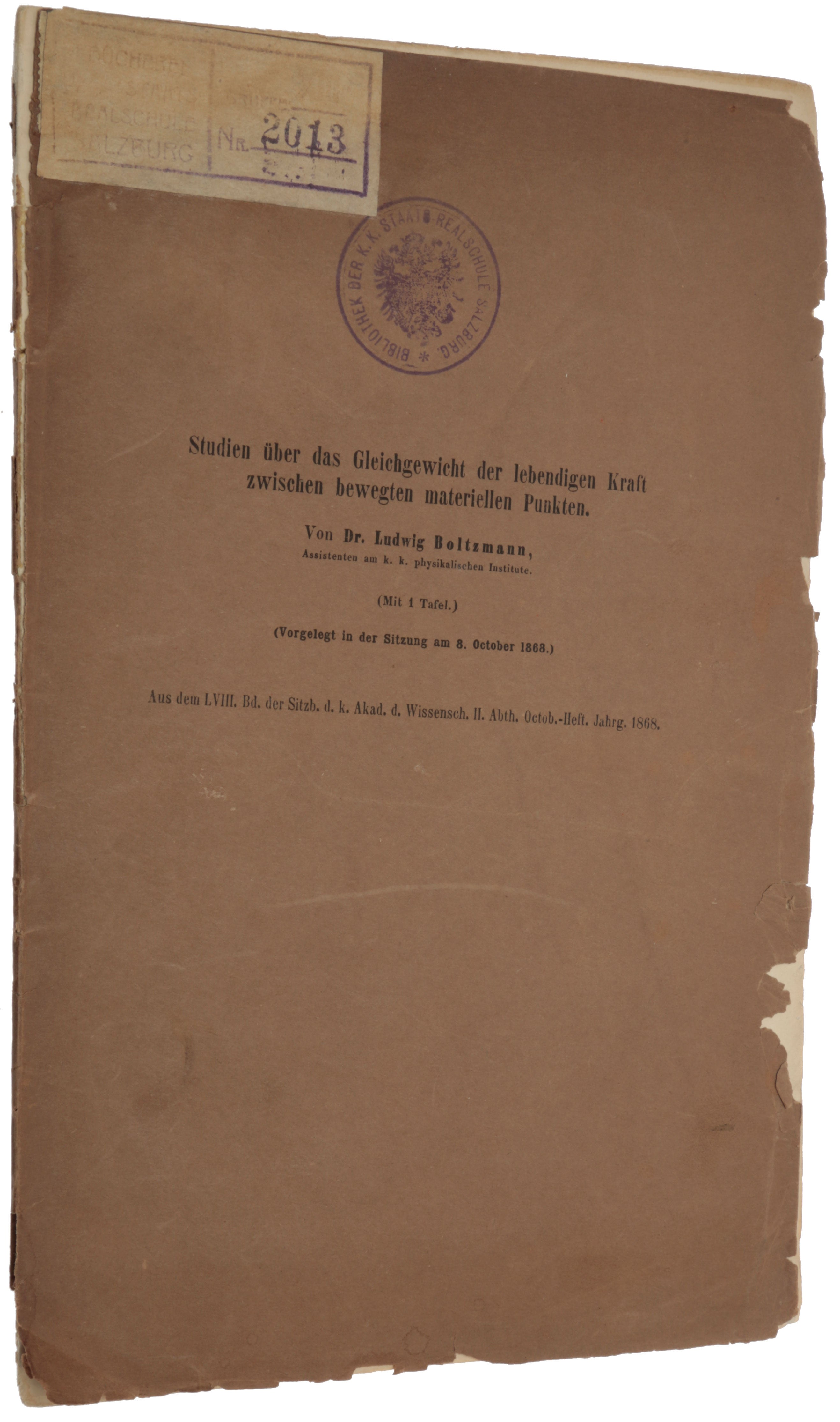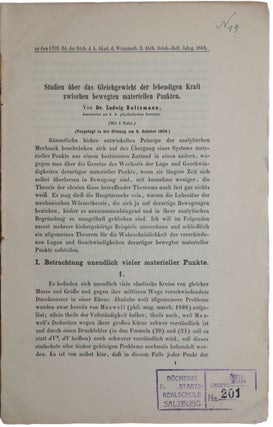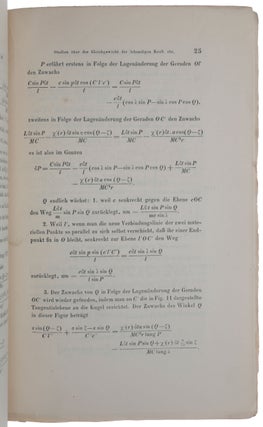Studien über das Gleichgewicht der lebendigen Kraft zwischen bewegten materiellen Punkten. Offprint from: Sitzungsberichte der kaiserlichen Akademie der Wissenschaften, LVIII. Band, Jahrgang 1868.
[Wien: K.K. Hof und Staatsdruckerei, 1868]. First edition, extremely rare offprint, of one of Boltzmann’s most important papers, in which he derives the ‘Boltzmann distribution,’ and formulates it as a probability distribution defined over phase space, instead of the space of molecular velocities – “This is the first occasion where probability considerations are applied to the state of the mechanical system as whole, instead of its individual particles” (Uffink, p. 957). Boltzmann also introduced here what became known as the ‘ergodic hypothesis’, an elusive idea that was central to future work in statistical mechanics. In papers of 1860 and 1867, James Clerk Maxwell had derived the distribution of velocities of a system of interacting particles, but only in two special cases in which the interactions took particular forms. In the present paper, Boltzmann generalized Maxwell’s derivation to the case of arbitrary inter-particle forces. “Maxwell had derived his equilibrium distribution for two special gas models (i.e., a hard sphere gas in 1860 and a model of point particles with a central r5 repulsive force acting between them in 1867). He had noticed that the distribution, once attained, will remain stationary in time, and also argued (but not very convincingly) that it was the only such stationary distribution” (Uffink, p. 953). “In this paper, [Boltzmann] extended Maxwell’s theory of the distribution of energy among colliding gas molecules, treating the case when external forces are present. The result was a new exponential formula for molecular distribution, now known as the ‘Boltzmann factor’ and basic to all modern calculations in statistical mechanics” (DSB). “In this paper Boltzmann did more than furthering Maxwell’s line of thought: he elaborated a general theorem which led him to prove the necessity of the Maxwell distribution” (Badino, p. 6). “In the same paper of 1868, Boltzmann presented another derivation of the Maxwell distribution law that was independent of any assumptions about collisions between molecules. He simply assumed that there is a fixed total amount of energy to be distributed among a finite number of molecules, in such a way that all combinations of energies are equally probable … By regarding the total energy as being divided into small but finite quanta, he could treat this as a problem of combinatorial analysis. He obtained a rather complicated formula that reduced to the Maxwell velocity-distribution law in the limit of an infinite number of molecules and infinitesimal energy quanta” (DSB). “This is the first occasion where probability considerations are applied to the state of the mechanical system as whole, instead of its individual particles. If the transition between kinetic gas theory and statistical mechanics may be identified with this caesura (as argued by the Ehrenfests), it would seem that the transition has already been made right here … Most importantly, [Boltzmann’s] results open up a perspective of great generality. It suggests that the probability of the molecular velocities for an isolated system in a stationary state will always assume the Maxwellian form if the number of particles tends to infinity. Notably, this proof seems to completely dispense with any particular assumption about collisions, or other details of the mechanical model involved, apart from the assumption that it is Hamiltonian. Indeed it need not even represent a gas … The [procedure of] letting the number of particles become infinite also seems to be the first instance of a thermodynamical limit … The main weakness of the present result is its assumption that the trajectory actually visits all points on the energy hypersurface. This is nowadays called the ergodic hypothesis” (Uffink, p. 957). The offprints of Boltzmann’s early papers in the Wiener Berichte are all of extreme rarity. OCLC lists just four copies of the present offprint worldwide (Cornell, Museo Galileo, and two in Berlin); no copies in auction records. “In the first section of [the present paper], Boltzmann aims to reproduce and improve [Maxwell’s] results for a system of an infinite number of hard discs moving in a plane. He regards it as obvious that the equilibrium distribution should be independent of the position of the discs, and that every direction of their velocities is equally probable. It is therefore sufficient to consider the probability distribution over the various values of the velocity v. However, Boltzmann started out with a somewhat different interpretation of probability in mind than Maxwell. He introduced the probability distribution as follows: ‘Let φ(v)dv be the sum of all the instants of time during which the velocity of a disc in the course of a very long time lies between v and v + dv, and let N be the number of discs which on average are located in a unit surface area, then Nφ(v)dv is the number of discs per unit surface whose velocities lie between v and v + dv.’ “Thus, φ(v)dv is introduced as the relative time during which a (given) disc has a particular velocity. But, in the same breath, this is identified with the relative number of discs with this velocity. “This remarkable quote shows how he identified two different meanings for the same function. We shall see that this equivocation returned in different guises again and again in Boltzmann’s writings. Indeed, it is, I believe, the very heart of the ergodic problem, put forward so prominently by the Ehrenfests … “Next he goes into a detailed mechanical description of a two-disc collision process. If the variables which specify the initial velocities of two discs before the collision lie within a given infinitesimal range, Boltzmann determines how the collision will transform the initial values of these velocities (v1, v2) into the final values (w1, w2)” (Uffink, pp. 953-954). Boltzmann assumes the Stoßzahlansatz, according to which the velocities of the different discs are uncorrelated. Using this, he shows that if the distribution function φ is to be stationary (i.e., does not change with time), it must satisfy the condition φ(v1)φ(v2) / v1v2 = φ(w1)φ(w2) / w1w2 (*) Boltzmann shows that the only function satisfying (*) for all choices of v1, v2, w1, w2 subject to the condition of conservation of kinetic energy v12 + v22 = w12 + w22 is φ(v) = 2hvexp(–hv2)for some constant h. From this Boltzmann recovers the Maxwell distribution. “In the next subsections, Boltzmann repeats the derivation, each time in slightly different settings. First, he goes over to the three-dimensional version of the problem, assuming a system of hard spheres, and supposes that one special sphere is accelerated by an external potential … In a subsequent subsection, he replaces the spheres by material points with a short-range interaction potential and reaches a similar result. “At this point, (the end of Section I), the argument suddenly switches course. Instead of continuing in this fashion, Boltzmann announces that all the cases treated, and others yet untreated, follow from a much more general theorem. This theorem, which, as we shall see relies on the ergodic hypothesis, is the subject of the second and third Sections of the paper” (ibid., pp. 954-955). “The theorem is formulated in the final section significantly entitled ‘Allgemeine Lösung des Problems des Gleichgewichtes der lebendigen Kraft’ (General solution to the problem of equilibrium of kinetic energy). Boltzmann considered a system made up of n particles moving in a volume and interacting according to an arbitrary potential function. Furthermore, the total energy of the system is now a fixed quantity. This last requirement modifies substantially the condition (*) because the probability for a particle to have a certain velocity is no longer independent of the velocities of the remaining particles: ‘The probability that the velocity of one point lies within given limits and, at the same time, the velocity of another lies within other limits will be by no means the product of the two individual probabilities; rather, the second one will depend on the quantity of velocity of the first point.’ “The equilibrium condition must be modified accordingly: Boltzmann has to shift his focus from the distribution function of a single velocity to the distribution function expressing the state of the system as a whole. By replacing Boltzmann’s inconvenient notation with modern phase space terminology, this means that the description of the system is now provided by the function ƒ(q1, …, qn, p1, …, pn)dq1 … dqndp1 … dpn (which we abbreviate to f(q, p)dqdp), giving the fraction of time spent by the system in the 2n-dimensional phase space region characterized by the values (q, q + dq) of the generalized coordinates and (p, p + dp) of the conjugate momenta. This phase region is transformed under the effect of the equations of motion: after a time interval δt, the system will lie in the region values (q’, q’ + dq’; p’, p’ + dp’) and the function becomes f(q’, p’)dq’dp’; after 2δt it becomes f(q”, p”)dq”dp”; and so on. Since the time intervals are equal, Boltzmann argued, the system spends equal amount of time in each region, therefore f(q, p)dqdp = f(q’, p’)dq’dp’ = f(q”, p”)dq”dp”, etc. “Next, Boltzmann calculated how the phase volume is transformed by the evolution of the system. The result is a special case of the Liouville theorem according to which the phase space volume singled out by the particles of the system does not change with time, that is dqdp = dq′dp′ … “Putting together all these results, Boltzmann arrived at the general condition of stationarity for a system under the constraint of the total energy: f(q, p) = f(q’, p’) = f(q”, p”) etc. Now, since this condition holds for the entire trajectory, it entails that the stationary distribution function must be a constant of motion, ƒ(q, p) = h. “From this theorem Boltzmann drew important consequences. First, the probability for a system to be in a certain state is proportional to the volume dqdp of the state: ƒ(q, p)dqdp∝dqdp. In other words, equal volume states are equiprobable. Second, the distribution is a function of the total energy only. “This theorem founds a completely new approach to the calculation of the specific form of the equilibrium distribution. Instead of investigating the average behavior of the system during mechanical collisions, one can divide the space of the allowed states into regions of equal volume and evaluate the probability for a single particle to be into a certain region. This probability, according to Boltzmann, is proportional to the number of ways in which the remaining particles can be arranged into the remaining regions. Because of the energy constraint, the fact that a particle lies in a certain state entails that some of the states are no longer reachable for the rest of the system. As an extreme example, if one particle owns the whole energy of the system, only the states with zero energy are allowed to the other particles. Thus, the number of combinations that the rest of the system can assume is a measure of the probability for a particle to lie in a certain state. This procedure is fully combinatorial and relies on the fact that the distribution is a function of the total energy only. “Boltzmann developed this procedure for a system of particles moving on a surface (two-dimensional case) and in a volume (three-dimensional case). The first example is very instructive because Boltzmann arrived at the final formula by increasing progressively the complexity of the system. He assumed the energy to be divided into p elements of magnitude ε and calculated the probability for a molecule to have energy between iε and (i + 1)ε. He began with two molecules (n = 2) and showed how to construct the combinatorial formula for increasing n. The general expression turned out to be a special case of the Polya distribution. To obtain the Maxwell distribution in two dimensions, Boltzmann calculated the limits n → ∞ and p → ∞. For the three-dimensional case the procedure is completely analogous except that Boltzmann considered infinitesimal energy cells and replaced the combinatorial formula with integrals. Again, the idea is that the probability for a particle to lie in a certain state is given by integrating over all possible states accessible to the remaining particles. The result is a complex expression containing Gamma functions which can be reduced to the Maxwell distribution by taking the limit n → ∞. “The theorem of the ‘Allegemein Lösung’ and the combinatorial argument represent a remarkable step forward that ‘fills a gap in all other derivations’ because they entail ‘not only that for [Maxwell’s] distribution of velocity the equilibrium takes place, but also that the [equilibrium] is possible in no other way’ … Here the Austrian physicist claims that, contrary to the kinetic approach, the combinatorial argument yields a proof of the necessity of the Maxwell distribution. The necessity relies, obviously, on the fact that this distribution is the most probable among the possible ways to distribute the time spent by a single particle in each state. This result would mark Boltzmann’s research program in the subsequent years … “On the last page of the paper Boltzmann discussed the limitations of his procedure. The combinatorial calculation relies on the assumption that all states allowed by the total energy condition will be eventually passed through by the system. This assumption will come to be known as ‘ergodic hypothesis’ and is essential to the combinatorial procedure. If the actual trajectory of the system is constrained into a fraction of the possible states, the combinatorial procedure does not provide any information on the equilibrium. Boltzmann argued that this occurs when the phase variables are not independent, but are interwoven by some constraint. Specifically, there are two cases in which such a phenomenon can happen. First, the system is strictly periodic and the trajectory closes itself ‘without having assumed all values compatible with the principle of energy.’ This is a case of stable ‘false equilibrium’ to which the combinatorial procedure does not apply. Alternatively, the system can present an unstable ‘false equilibrium’. This occurs when the particles are arranged in a very peculiar way, which forces the system into a weird, pathological behavior. Boltzmann mentioned the example of gas molecules lined on a straight line. If the line is perfectly straight and the molecules are properly directed, they will continue to oscillate along it without reaching the homogeneous and isotropic distribution they are theoretically capable of. Boltzmann clearly considered these microarrangements as improbable. Although he could not provide a formal proof, he appeared to think “The device of starting with finite energy quanta and then letting them become infinitesimal is not essential to such a derivation, but it reveals an interesting feature of Boltzmann’s mathematical approach. Boltzmann asserted on several occasions that a derivation based on infinite or infinitesimal quantities is not really rigorous unless it can also be carried through with finite quantities. While this prejudice kept him from appreciating and using some of the developments in pure mathematics that appeared toward the end of the nineteenth century, it also had the curious effect of making some of his equations for energy distribution and transfer look similar to those of modern quantum theory. (This is perhaps not quite accidental, since Planck and other early quantum theories were familiar with Boltzmann’s works and used many of his techniques)” (DSB). Boltzmann’s paper not only marks a turning point in statistical mechanics, it is also an important contribution to statistics itself. “In 1868 Boltzmann calculated the marginal distribution of energy for a molecule, that is, the probability that a molecule has a certain energy independent of the energy distribution of the other molecules. To perform his calculation, Boltzmann assumed that the energy was divided in many intervals of equal dimension and defined probability in a classical way as the ratio between favorable cases and total cases. It is worth noting that Boltzmann’s marginal argument is probabilistically exact, because it uses classical probability rather than relative frequencies. In 1927 a similar procedure was used by Louis Brillouin in his important paper on quantum statistics. Furthermore, a deep analysis shows that Boltzmann was able to derive and to apply statistical distributions that would be studied by professional statisticians only many years later, notably the Polya bivariate distribution, the Beta distribution, and the Gamma distribution” (New DSB). “The relationship between Poisson and exponential distributions was noted in a physical context in ‘Studien uber das Gleichgewicht der lebendigen Kraft zwischen bewegten materiellen Punkten’ by L. Boltzmann in 1868 … Yet, it took about another 50 years for the general acceptance of the exponential distribution in statistical circles” (Balakrishnan, The Exponential Distribution, p. 3). Ludwig Boltzmann (1844-1906) received his doctorate from the University of Vienna in 1863, just three years after matriculating. In 1869 Boltzmann left Vienna to become a professor of physics at the University of Graz. He left Graz for Vienna in 1873, but then returned to Graz in 1876, where he stayed until 1890. Badino, ‘Mechanistic slumber vs. statistical insomnia: The early phase of Boltzmann’s H-theorem (1868-1877),’ European Physical Journal H 36 (2011), pp. 353-378. Uffink, ‘Compendium of the foundations of classical statistical physics,’ pp. 923-1074 in Philosophy of Physics, Butterfield & Earman (eds.), 2007.
that an increasing number of particles would make these arrangements even
more unstable and therefore improbable” (Badino, pp. 358-361).
8vo (245 x 157 mm), pp. 44 and one folding plate. Original printed wrappers (spine and front wrapper chipped at edges, institutional stamp on front wrapper and blank margin of first page of text).
Item #5812
Price: $12,500.00







